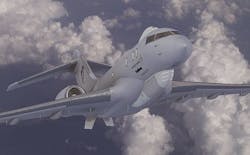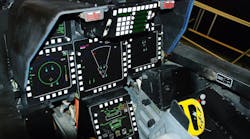The idea is to package the Joint STARS synthetic aperture radar (SAR) ground moving target indicator (GMTI) onto an aircraft smaller than the Boeing 707 jetliner aircraft on which the system is housed today.
Officials of the Air Force Life Cycle Management Center at Hanscom Air Force Base, Mass., awarded deliver orders this week to three major defense primes for pre-engineering and manufacturing development (pre-EMD) as part of the Joint STARS recapitalization program.
Joint STARS recapitalization contracts this week went to Lockheed Martin Corp. of King of Prussia, Pa.; the Northrop Grumman Corp Aerospace Systems segment in Melbourne, Fla.; and Boeing Service Co. in Richardson, Texas.
Joint STARS recapitalization is intended to Joint STARS ground-surveillance capability off of its 707 jetliner platform and onto an aircraft that is less expensive to maintain and operate.
Related: Avionics upgrades keep military planes flying
The three companies will perform pre-EMD work on the Joint STARS recapitalization program, which consists of assessing the maturity of subsystem technology, reducing weapon system integration risks, and reducing life cycle cost by virtue of design. These efforts will help the Air Force refine Joint STARS recapitalization requirements, identify costs, and reduce design risks.
The current Joint STARS system is designed onto the Boeing 707 four-engine jet that originally was developed in the late 1950s as a passenger jetliner. The plane has not been manufactured in more than 30 years, and is expensive to operate and maintain.
Instead, Air Force officials want to repackage Joint STARS capability on a smaller airframe like a business jet or on a Boeing 737 small passenger airliner.
For the aircraft's surveillance sensors and other electronics, the Air Force wants to use an open-systems architecture that enables technicians to integrate new capabilities onto the aircraft quickly and more efficiently than is possible today on the 707 platform.
The Joint STARS SAR and GMTI systems represent an airborne battle management command and control capability that detects, tracks, and identifies moving military vehicles or foot soldiers, slow-moving fixed-wing aircraft and helicopters, as well as surface ships at sea.
story continues below
Lockheed Martin, Northrop Grumman, and Boeing are defining the future Joint STARS aircraft, as well as its sensors, battle management, and communications. The government eventually will acquire the system using a multiple contracts strategy, officials say.
Air Force leaders ultimately want to develop a redesigned Joint STARS aircraft and on-board electronics in time to deploy by 2022. The new system will have the same or better capabilities than today's Joint STARS aircraft, yet with reduced systems-integration, operating, and sustainment costs.
Air Force officials also want to design a new Joint STARS system that can promote increased competition among defense contractors for systems upgrades and technology insertion.
Lockheed Martin is working with partners Raytheon and Bombardier are working on a design to be based on a Bombardier business jet. Northrop Grumman is working with partners the Gulfstream subsidiary of General Dynamics and L-3 Communications on a system based on a Gulfstream business jet. Boeing, meanwhile, is proposing a solution based on the company's 737 single-aisle jetliner aircraft.
Of the delivery orders announced this week, Lockheed Martin will receive $11.5 million and do the work in King of Prussia, Pa. Northrop Grumman is receiving $10 million and will do the work in Melbourne, Fla. Boeing is receiving $9.9 million and will do its work in Seattle. All three companies should be finished by July 2016.



